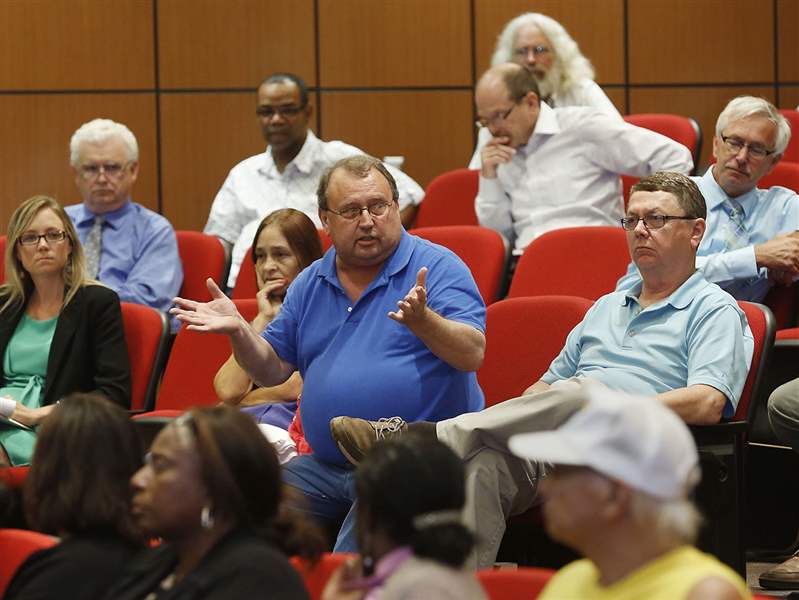
Few attend sewer-rate session
Water crisis draws comments; cost increases go unmentioned
8/11/2014
West Toledoan Mike Kookoothe speaks out during a public meeting at the Main Toledo-Lucas County Public Library downtown.
THE BLADE/LORI KING
Buy This Image

West Toledoan Mike Kookoothe speaks out during a public meeting at the Main Toledo-Lucas County Public Library downtown.
The sewer-rate increases keep on coming for the Toledo Waterways Initiative, but so too do the projects designed to reduce the city’s sewage pollution by 80 percent, city officials said during a hearing Monday evening.
Finishing the last of 45 projects to expand Toledo’s sewage treatment plant and manage peak volumes flowing into it to eliminate overflows into rivers is what city customers will get for a 52 percent rate increase spread out in chunks over six years, Julie Cousino, the construction program’s city manager, told an audience of a few dozen at the Main Library downtown.
Residents can check the frequency and duration of sewage spills on the Toledo Waterways Initiative Web site, www.toledowaterwaysinitiative.com
Go to the Tech Data heading.
“I was hoping to have a full house. We really want to get the benefits of the Toledo Waterways Initiative out to the public,” Ms. Cousino said afterward.
But at least a few of those in attendance were more concerned with Toledo’s recent drinking-water crisis than they were with the sewer upgrades. None who spoke about the latter voiced any opinion about the rate increases, which also will be the subject of a city council meeting next week.
If the increases are approved, a Toledo water customer using 3,000 cubic feet of water each quarter will get a $160.70 sewer bill next year, up from $150.05 this year, and will pay $228.40 every three months when the last, 7.9 percent hike takes effect in 2020.
That’s close to four times the typical $61.84 quarterly sewer bill the city charged in 2003 when the program started. Ms. Cousino noted that some increases would have occurred anyway because of generally rising operating costs.
The Toledo Waterways Initiative, proposed by city officials to settle an 11-year U.S. Environmental Protection Agency lawsuit and approved by voters at a 2002 referendum, was initially budgeted at $450 million. It’s now expected to cost $521 million when completed.
The program has included plant improvements that increased its daily treatment capacity from 195 million gallons to 400 million gallons; construction of new sewer mains in selected neighborhoods that allow the old sewers to be used strictly for storm drainage, and building of massive underground lagoons in other areas that regulate sewer flow so storm peaks don’t overload the plant.
Its goal is to eliminate 650 million gallons annually of raw or partially treated sewage discharges into the Maumee and Ottawa rivers and Swan Creek, or 80 percent of such discharges from the city sewer system.
Among projects still to be built is the program’s largest, a 36-million gallon retention basin and pump station beneath Joe E. Brown Park on Manhattan Boulevard.

Yvonne Harper, executive director of the Lucas County Democratic Party, makes a statement at the meeting.
The project is slated to start by Jan. 1 and is expected to cost $88 million. Its completion should reduce basement flooding in the surrounding neighborhood and allow a do-not-touch order for part of the Ottawa River to be lifted, Ms. Cousino said.
Ed Moore, Toledo’s public utilities director, was adamant that the Toledo Waterways Initiative is distinct from money Toledo is spending on its water plant.
“These are two separate utilities. These two programs are not related,” he said, referring also to $264 million in improvements Toledo is making to its aging water treatment plant.
“We need to focus on the quality of water in Lake Erie. ... That’s absolutely what our focus should be on,” Mr. Moore said. “Our plant is fine.”
Along with agricultural fertilizer runoff, sewage discharges are considered a major contributor to algae blooms on Lake Erie such as the one that prompted the Aug. 2-4 do-not-drink order for Toledo’s water supply.
Yvonne Harper, executive director of the Lucas County Democratic Party, called on city officials to be “up front and honest” about city water quality issues before they reach a crisis point.
“What about us citizens?” she said. “We’re the ones that are being frightened.”
Audience member Sandra Frank, meanwhile, asked if city officials had yet calculated the water scare’s economic impact on the city.
Mr. Moore responded that the city would need to get estimates from private businesses, which they haven’t done.
Emergency water distribution, he said, cost the city $207,000 directly.
City Council’s meeting about the rate increases is scheduled for 4 p.m. Aug. 20 in council chambers at One Government Center.
Contact David Patch at: dpatch@theblade.com or 419-724-6094.